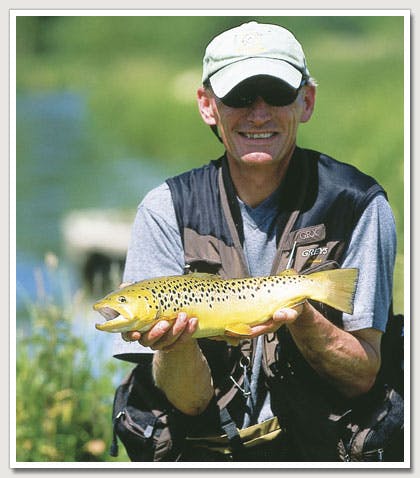TOP TIPS FOR CATCHING TROUT DURING A SUMMER HEATWAVE
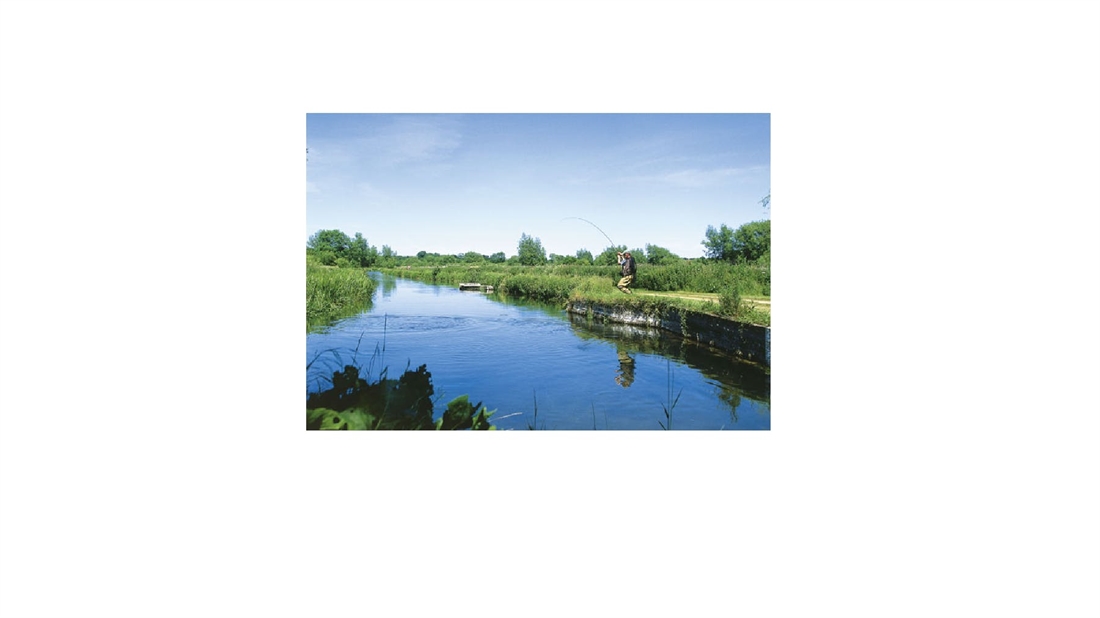
When the sun’s blazing out of a cloudless sky and the fish are holed up hard on the streambed, it can be as hard to get a take as it is in the depths of winter.
So what tactics will work on those impossibly hot days in high summer? It’s pretty simple really, explains Baz Reece – the same tricks that you’d employ in the middle of winter.
“IT’S GOING to be a real ‘bonceburner’,“ observes England international Baz Reece, as he surveys the cloudless cobalt sky through his oversize Polaroids.
We’ve just arrived at the renowned Lower Itchen Fishery on the hottest day of the year and it’s clear that the conditions are far from ideal for flyfishing.
Famed for its big brownies and grayling, the Lower Itchen beats are also acknowledged as being one of the few day ticket fisheries in the south offering a realistic chance of connecting with a sea trout or salmon.
Expectations of a memorable day’s fishing were reinforced when the day dawned cool and slightly overcast, but by 8am, the sun was beating down out of a crystal clear sky.
As the dreams of completing a ‘Hampshire McNab’ – brownie, grayling and sea trout in one session – melted like a mirage into the shimmering heat haze, we discussed the tactics that were going to deliver fish in these extreme conditions.
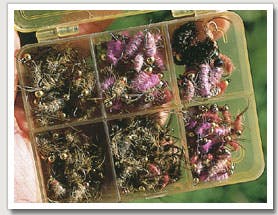
Baz pulls out a box of nymphs which rattles like a tin of heavy-duty nails. Inside are his ‘weapons of mass destruction’ – dozens of leaded and goldhead bugs weighing anything up to a quarter of an ounce. These lumps are designed to get down quickly and stay there… and they work.
“In these conditions, it’s pointless mucking around with more delicate patterns,” says Baz. “You’ve got to get down where the fish are quickly and stay there.”
Baz will use up to three of these depth charges on a 10 – 12-foot fluorocarbon leader, giving him almost an ounce of lead and beads to play with. He casts this unwieldy rig slightly upstream on a short line of between five and 10 yards and lets the bugs hit the deck before gently working them downstream through the deeper pools and runs of the gin-clear waters of the Itchen.
Purists could be forgiven for making comparisons between this and the coarse technique of fishing a rolling leger or ‘bouncing bomb’, but if the fish are hard on the bottom and you have a choice between fishing deep or going home, the aesthetics usually play second fiddle to the practicalities – especially if you’ve parted with £60 for a day’s fishing.
Yet even with this devastatingly effective technique, after 45 minutes’ plugging away with the bugs, we haven’t even seen a fish, let alone caught one. We’re both beginning to worry that the conditions are so tricky that we’re really going to struggle to grind out a couple of fish.
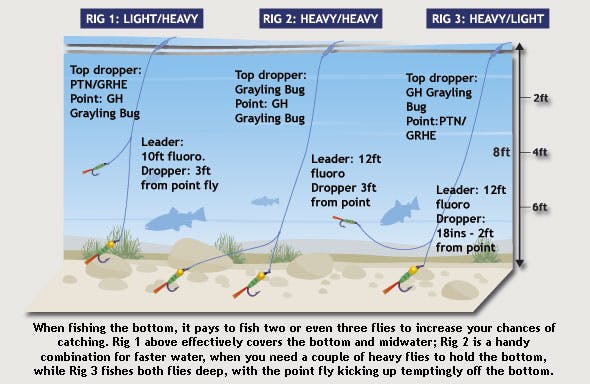
ACQUIRING A SIXTH SENSE
Despite the distinct lack of action, by methodically working his team of bugs through the swims, Baz is building up a picture of the bottom. He’s watching the leader for the slightest twitch and feeling his way around the riverbed, distinguishing between rocks, weedbeds and what could be a genuine take.
Just as I’m beginning to get seriously concerned, Baz strikes and his rod bends into a decent fish. After a lively scrap in the flow, Baz puts a 1lb 8oz grayling on the bank. Having failed to register any form of take, I ask him how he spotted the bite.
“It’s hard to describe, but you just know it’s there,” said Baz. “If I’m fishing upstream, I’ll watch the line for twitches, otherwise, it’s just down to intuition. It’s different when you can see the fish, because you’re watching for a movement of the mouth when they take it, but if you’re fishing blind. Be it right or wrong, I won’t use sight bobs; you’ve just got to develop a ‘feel’ for it and the more you do it, the easier it gets.”
The pod of fish that Baz has located are shoaled up in a deeper run which the faster water on the outside of a bend has scoured out. It’s a typical grayling lie.
“If you can’t actually see the fish, you’ve got to start by prospecting the likely-looking areas,” explains Baz. “You’re looking for areas where the bottom shelves off and deepens – that’s where you’ll usually find a shoal. It’s also worth trying behind and in front of rocks and boulders in the flow and behind or between clumps of weed.”
Once we’d located the grayling lie, peering into the depths revealed the odd glimpse of tail or fin and the occasional flash as a fish moved to Baz’s bugs.
Confidence restored somewhat, we head off upstream in search of more sport.
Even though we’re less than a mile from Southampton’s sprawling suburbs, the dense vegetation of the Itchen flood plain provides excellent sound insulation and it’s only the odd aircraft taking off from nearby Eastleigh airport that reminds us we’re within spitting distance of civilisation.
Overhead, a couple of little egrets struggle through the air with laboured wingbeats and in a little clearing in the trees, a pair of hobbies hawk insects in the heat while in the distance, buzzards mew plaintively as they circle effortlessly on the thermals. Even if the fishing’s a bit tough, it’s a great day to be outdoors and a hard day on the water is always going to top a good day at the office.
Buoyed by our success with the grayling and picking up more and more signs of life as our eyes tuned in to the right frequency, we attempted to catch a couple of vaguely alert brownies with dries, but they were too torpid to even investigate our delicate offerings. We were forced to revert to the heavy bugs, but opted for a more visual approach and began to target individual fish.
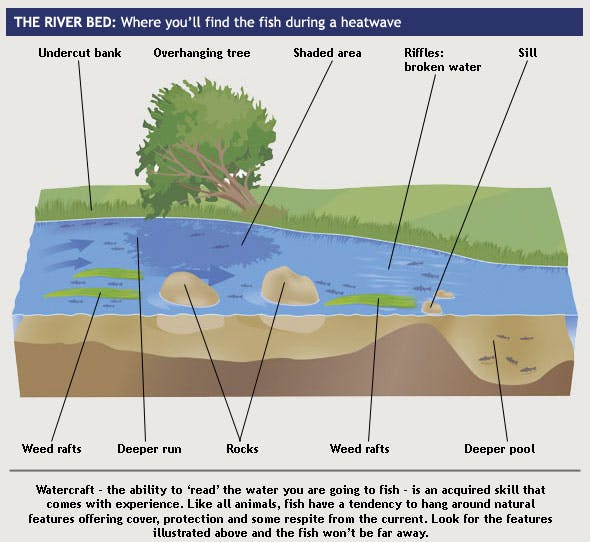
HOW TO SPOT FISH
Even in the crystal clear water of the southern chalkstreams, it can be extremely difficult to see what’s right in front of your nose. Anglers who have been lucky enough to have a crack at bonefish in the tropics will tell you that these ‘silver ghosts’ are virtually impossible to spot, but trout and especially grayling can be just as tricky.
Polarising sunglasses are an absolute must – without them you’ll struggle to see through the surface glare to the depths beneath.
In order to see the fish, it’s important not to scare them off first, but unless you’re really stealthy, you can empty a whole stretch of river before even setting eyes on a fish. So keep low on the skyline, avoid throwing any shadows on the water, make use of the cover afforded by bankside vegetation and move around quietly and slowly.
Take your time. Just like a batsman needs time to get his ‘eye in’ and your night vision takes a while to kick in on a dark night, it takes time for your eyes to adjust to the aquatic environment. But once you’ve spotted your first fish, you soon start picking up more and more.
Grayling are much trickier than trout – often you’ll only see a tail gently waving to hold the fish on station or you’ll catch a fleeting glimpse of a shadow moving across the bottom.
“You’re just looking for shapes or shadows,” says Baz. “You have to look where you’d expect to find fish. Sometimes you’ll make a mistake, but it doesn’t really matter if you waste a few casts targeting a piece of weed!”
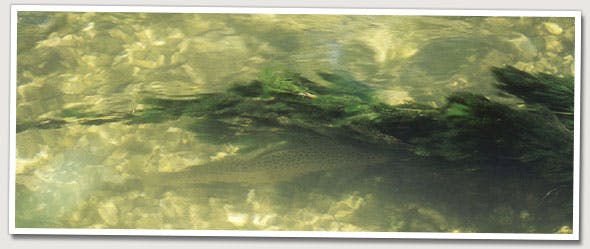
KEEPING TRACK OF THE FLIES
We spot a good fish holding in a pool and have a cast at it. He isn’t particularly interested, but on the third cast, three fish appear from nowhere and start competing for the bug.
“That’s why it’s important to watch the flies, not the fish you are targeting,” says Baz. “And if you can’t actually see the flies, then try to imagine where they are in the water and follow them. If you’re watching the fish, you’ll just be in time to see the fish you hadn’t seen rejecting your fly. “
If visibility is proving a problem, it’s worth trying a bigger or brighter bug that you can see more easily.
Baz finds a shoal of big grayling in a deep scour behind a small groyne and drops his bugs a couple of yards upstream of the pod. He lets the bugs hit the bottom and then works them downstream with gentle lifts of the rod. If the fish don’t hit the bugs of their own accord, Baz lifts smartly to induce a take and the fish just can’t resist snatching at them.
You’ve got to be quick to hook them – in fact the lift to induce the take and the strike to set the hook should merge into virtually one smooth but deliberate movement.
This pool produces a brace of grayling of 2lb 8oz or more and Baz is starting to grow visibly in confidence. He’s got the method, he can see the fish and he’s in the groove.
We spot a big browie taking the odd olive from the top and Baz can’t resist a cast at him with his lightweight dry fly outfit. The fish has a look at the fly but rejects it and goes down, so it’s back to the bugs for the time being.
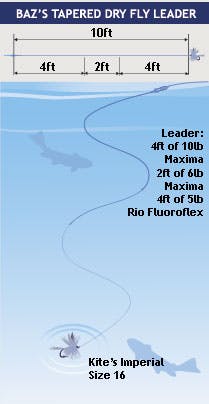
DRY FLY FINALE
By mid afternoon, Baz has added several more trout and grayling, plus a 1 lb chub to his portfolio. The fish are noticeably more active and a few are ‘on the fin’ and looking upwards for insects on the surface.
I hook a lively brownie which appears from the depths of a weir pool to snatch a weighted nymph and careers off across the current. These Itchen trout are powerful, muscular fish and although it probably only just tips the scales at 2lb, it attempts to wrap the leader round a snag before charging off down stream and then holding in the current, shaking its head angrily. I have to use the full power of an eightweight rod to gain line on the fish and it’s a good five minutes before I can bring it to the net. Baz, meanwhile, has been stalking the big cock fish that refused his dry fly half an hour earlier.
“It’s a myth that chalkstream trout won’t take a fly again once you’ve pricked them and put them down,’ says Baz, as he creeps closer to his quarry. “All you need to do is rest the swim for a while and then try him with a different fly.”
Baz ties on a size 16 Kite’s Imperial onto a tapered leader and puts the fly delicately over the fish, which is hovering in midwater just under the far bank. The fish climbs lazily up in the water to take a closer look, but doesn’t seem particularly interested.
Baz gives the fly his ‘shake and vac’ treatment – dipping it into a bottle of silica crystals to dry it off – before preparing to recast.
SHAKE AND VAC
“I’ve tried all sorts of different floatants, but I reckon this is the best way of keeping a dry fly afloat,” he explains. “I never go anywhere without it because once a fly is water-logged, it’s nothing like as effective.”
Kite’s back in pristine condition, Baz puts it over the tish again, and he rises to have a look at it, following it downstream for an agonising couple of seconds and then decides to nail it. Baz lifts in to him and he goes ballistic, bending the lightweight Loomis alarmingly and stripping yards of line from the small reel.
After five minutes or so of surging, headshaking action, Baz has the fish under control and soon slides the net under the 3lb brownie. As is he lifts it onto the grass for unhooking, we admire its developing kype and burnished bronze flanks before releasing it back into the limpid water. It was a fitting moment to call it a day and head off to the inviting shade of the nearest beer garden. We’d failed to complete the hat-trick we set out to achieve, but the fishing, though demanding, had been no less rewarding for it.
